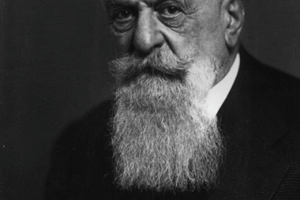Pretty Pig or Charming Chimp?
“My opinion of this animal has much improved during the course of my research. Where once I thought of filth and greed, I now think of intelligence, affection, loyalty, and adaptability, with an added touch of joyous sensuality – qualities without which humans would not be humans.”
Eugene M McCarthy, geneticist, 30 November 2013
The weight of cogent argument seems reasonable to me,
A theory that explains the way that people came to be,
The distinct possibility, the open minds avow,
That Adam was a chimpanzee and Eve a buxom sow.
Anon, 2013
***
A hundred years on and we might allow ourselves to have a guilty giggle at the expense of the once superfamous French-Russian-Jewish Dr Serge Abrahamovitch Voronoff, known to the world as “The Monkey Man”.
After all, having been lavishly funded in his innovative research efforts by his fabulously oil rich American science obsessed lab assistant Frances “Fannie” Evelyn Bostwick, Serge Voronoff launched his ubertreatment for the fast fading virility of the older variety of millionaire.
Having exhausted his go-to supply of testicles from newly killed criminals by 1917, Voronoff had perfected a surgical technique of tacking thin slices of chimpanzee or baboon testicular tissue on to the family jewels of those men who could afford the fee. With his success came worldwide fame and an eager following of fellow “organotherapists”.
As we now know for certain, these monkey gland grafts were promptly killed stone dead by the ever alert human immune system. It took more than a decade for the public to fully recognize this major misapprehension.
In 1921, Fannie Voronoff, aged 48, died – cause unknown – having been married for a year, leaving an eye-watering fortune to him himself, her fourth husband.
Eventually squeezed out of practice by universal opprobrium, Voronoff retired to live in princely splendor thenceforth, dying aged 85 at Lausanne, probably of a pulmonary embolus following a hip fracture.
***
Needless to say, grafts between dissimilar species, “xenotransplants”, were not given a great deal of attention over the next few dozen years, but the hypothesis of organ transplantation continued to gather unto itself a small band of discreet and dogged disciples.
In 1954, the first human to human transplant, an “allotransplant”, was attempted after much moralistic soul-searching, let alone much contemplation of the complex and abundant practical problems. Thirty seven years after Voronoff’s initiative had gained traction, a human kidney was given to a person in terminal renal failure. The surgery was highly successful but the patient died.
The kidney transplant was followed by the liver transplant in 1963, the pancreas and the heart in 1967 and the heart and lungs in 1981. In all early cases, sooner or a little later, the transplants succumbed to the immune system. Voronoff’s generation of doctors had been unaware of its overweening influence, indeed the scientific term “immune system” was not formally attested until 1917.
During the 1960’s, the newly developed azathioprine, in combination with the anti-inflammatory agent prednisone, was adopted as the preferred immunosuppressant in allotransplant surgery. This efficacious cocktail took the sting out of rejection, but, with the addition of cyclosporine to the mixture in the 1980’s, a much more impressive success rate was achieved.
The downside to immunosuppression remains the disablement of the body’s defenses against the organisms and mechanisms of disease, but further less toxic additions to the repertoire of immunosuppressants have dramatically improved the life expectancy of transplant recipients.
As at 2019, the US had one of the highest solid organ transplantation rates in the world at 106.1 transplants per million population, represented by –
- • 23,401 kidneys (survival 22.79 years)
- • 8,896 livers (survival 20.9 years)
- • 3,552 hearts (survival 14.82 years)
- • 2,714 lungs (survival 9.28 years)
Journal of Medical Economics, Vol 25, 2022
***
In the year 2022/2023, there was a significant increase in the receipt of donated organs for transplant. However, in the same period, there was an equal decline in consent for donation, leaving thousands with organ failure without the opportunity of transplant surgery. Consequently, there is now a newly urgent requirement for non-human organs – which is where Dr Eugene McCarthy of the University of Georgia comes in.
Dr McCarthy is a geneticist specialising in hybridisation. In 2013, he proposed his theory that humans developed as a result of the mating of pigs with chimpanzees – about 80 million years ago. McCarthy stood up sturdily to an immediate cacophony of scientific scorn – “what a loon!”. He had pointed out that humans have numerous distinctive porcine traits – such as hairless skin, a thick layer of subcutaneous fat, light coloured eyes, heavy eyelashes – and that there were a significant number of skeletal similarities. The genes were a problem in their fundamental dissimilarities, but then we are well aware of the duckbilled platypus – an undoubted long ago cross between an otter-like animal and a duck-like bird with a genome to match – not to speak of the very recent and fertile zedonk and geep.
This fierce academic debate apparently came to an abrupt end.
***
“The world’s first pig-to-human heart transplant, performed on 7 January, 2022 at the University of Maryland Medical Center, may or may not extend the life of transplant recipient David Bennett, 57” 12 January, 2022.
The pig in question had had ten genetic modifications. After all, for many years pig skin had been used to cover burn injuries, and pig heart valves used to replace diseased human equivalents.
Obviously, McCarthy’s hypothesis still holds water with transplant surgeons.
David Bennett died two months after his heart transplant from “hyperacute rejection”.
The frantic race to create humanoid pig organs is increasingly ferocious and costly, as hundreds of thousands world wide perish. Any convincing success would be magnificently profitable.
Voronoff would be really most pleased, but he would have preferred chimps.
Richard Petty




